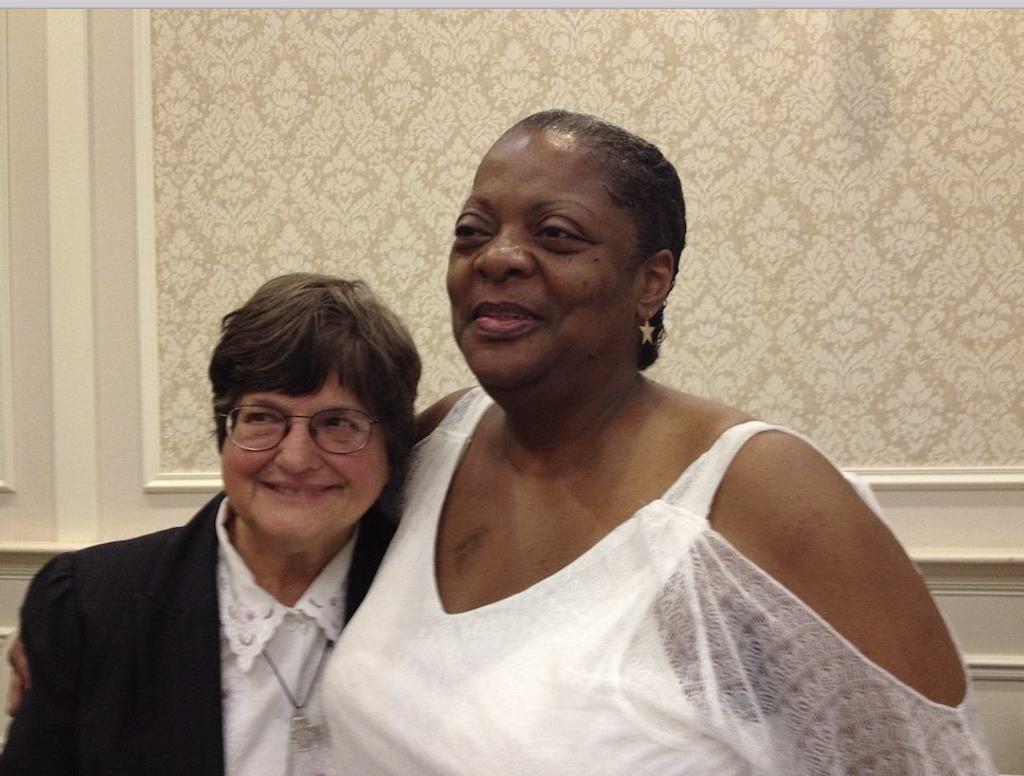
Sandra Lockett-Young (pictured, right, with Sister Helen Prejean), whose case established a capital defendant’s right to present a broad range of mitigating evidence concerning her character, background, and record and the circumstances of her offense, has died. Lockett had suffered a severe stroke in June 2019 from which she never recovered. She died in an Ohio hospice on February 26, 2020 at 65 years old.
Then 21 years old, Lockett was sentenced to death in 1975 under an Ohio law that required the court to impose the death penalty for “aggravated murder with specified circumstances,” unless certain narrow mitigating criteria were met. The law limited mitigating circumstances to three enumerated factors, that: (1) the victim had “induced or facilitated” the murder; (2) the defendant was “under duress, coercion, or strong provocation,” without which she was unlikely to have committed the murder; or (3) the murder was “primarily the product of … psychosis or mental deficiency.”
The evidence in Lockett’s case established that she was, at worst, a getaway driver who did not kill anyone, did not intend for anyone to be killed, and who had no prior felony convictions. However, none of the statutory mitigating factors applied to her case and she was sentenced to death. In 1978, her case, Lockett v. Ohio, struck down Ohio’s death-penalty law and produced a landmark 7-1 U.S. Supreme Court ruling requiring states to allow capital sentencing judges and juries to consider all relevant mitigating evidence.
In language repeated in numerous Supreme Court cases over the years, a plurality of four justices declared that the sentencer in a capital case may “not be precluded from considering, as a mitigating factor, any aspect of a defendant’s character or record and any of the circumstances of the offense that the defendant proffers as a basis for a sentence less than death.” With Justice Marshall concurring on the broader grounds that the death penalty was always cruel and unusual punishment, the Lockett doctrine became the constitutional law of the land and a key factor in narrowing the use of the death penalty nationwide.
As a result of the ruling, Lockett and approximately 100 other death-row prisoners in Ohio were resentenced to life with the possibility of parole — the alternative sentence for aggravated murder then authorized by Ohio law. Lockett-Young was released on parole in 1993 and frequently spoke against the death penalty.
In October 2018, the University of Akron Law School held a symposium to mark the 40th anniversary of Lockett v. Ohio and the continuing effects of the decision. Lockett-Young spoke at the symposium, along with her appellate attorneys, legal scholars, and DPIC’s Executive Director, Robert Dunham and Senior Director of Research and Special Projects, Ngozi Ndulue. Anthony Amsterdam, who argued on behalf of Lockett at the U.S. Supreme Court, shared his thoughts at the symposium, saying, “Sandra Lockett, whose strength of will and power to survive we are commemorating here, will take her rightful place in the history of the struggle for decency in criminal justice.” Several scholars, attorneys, and experts wrote papers for the symposium, discussing the critical role mitigation plays in capital cases today, and how the Lockett decision reshaped the course of the death penalty in the United States.
Sources
Lockett v. Ohio, 438 U.S. 586 (1978), Margery B. Koosed, INTRODUCTION TO THE “LOCKETT V. OHIO AT 40 SYMPOSIUM”: RETHINKING THE DEATH PENALTY 40 YEARS AFTER THE U.S. SUPREME COURT DECISION, University of Akron Law School Center for Constitutional Law, October 2018; People Staff, Death Row, U.s.a. — the Five Women Living Here May Be Running Out of Time, April 25, 1977.
You can read the Lockett Symposium articles here.
United States Supreme Court
Mar 22, 2024




